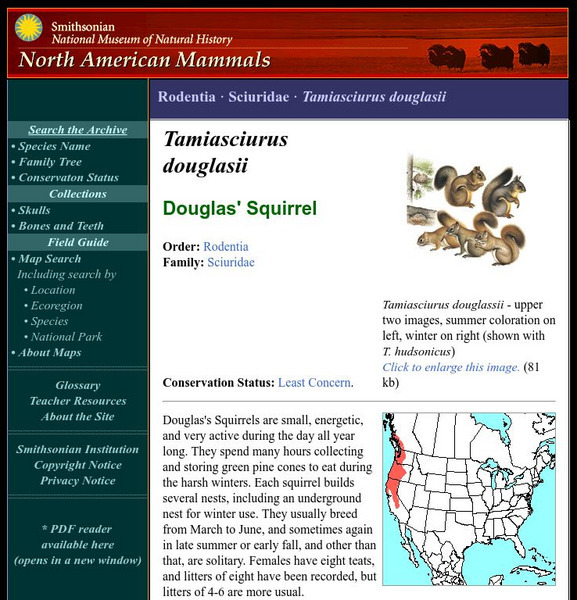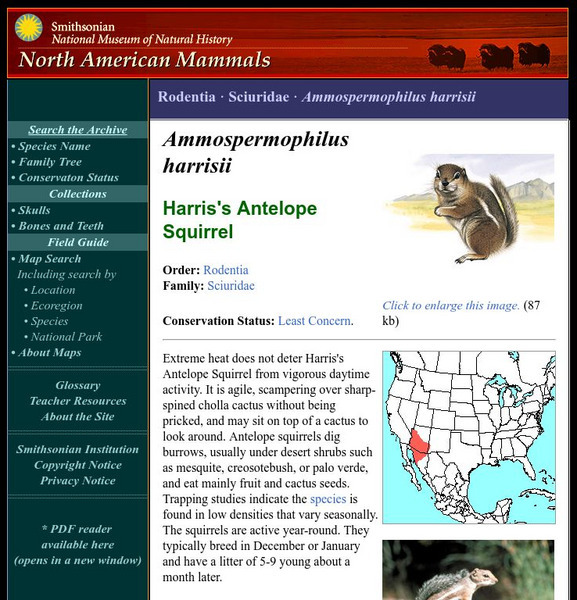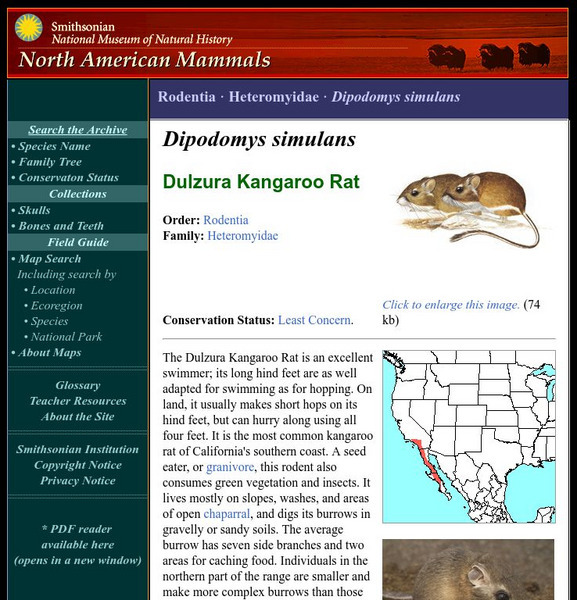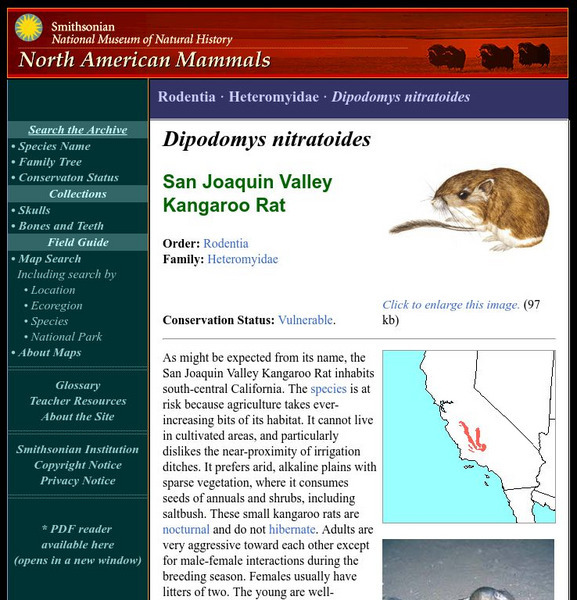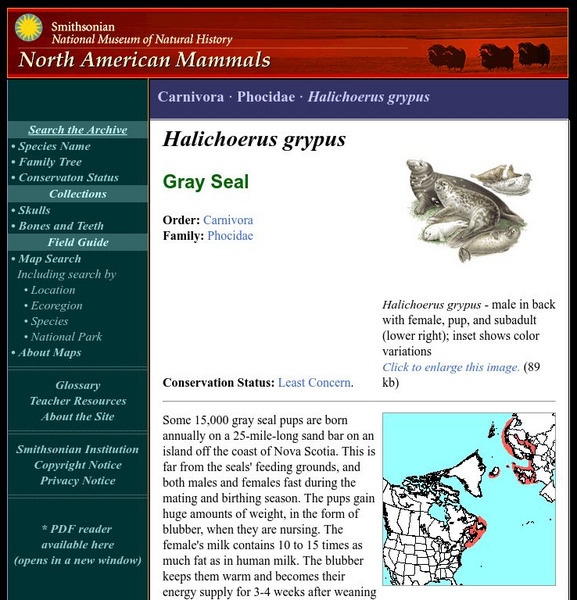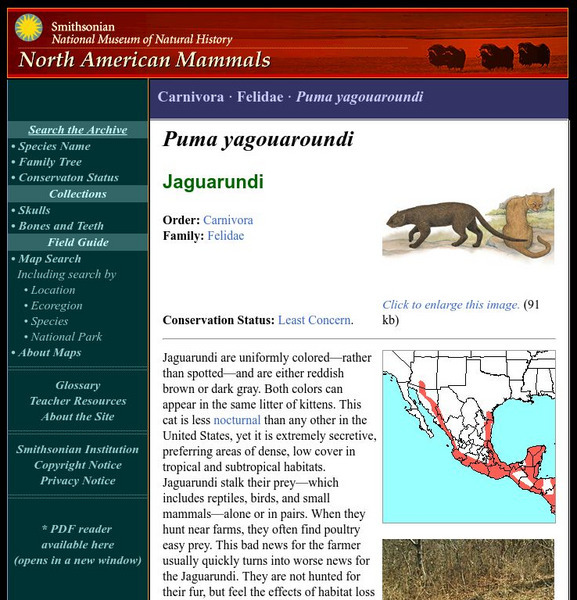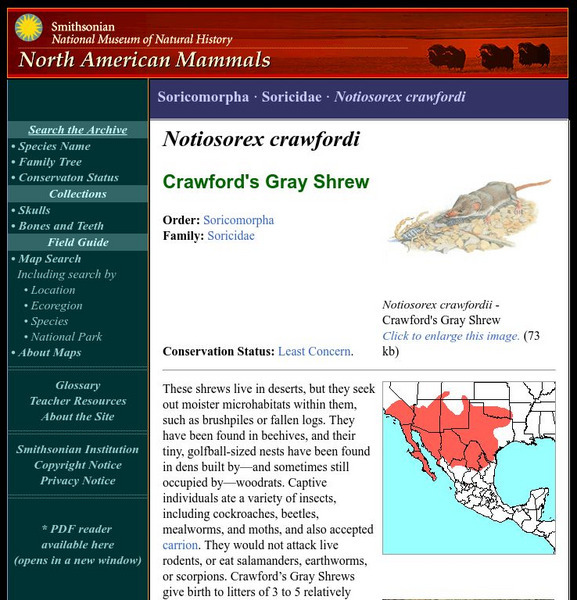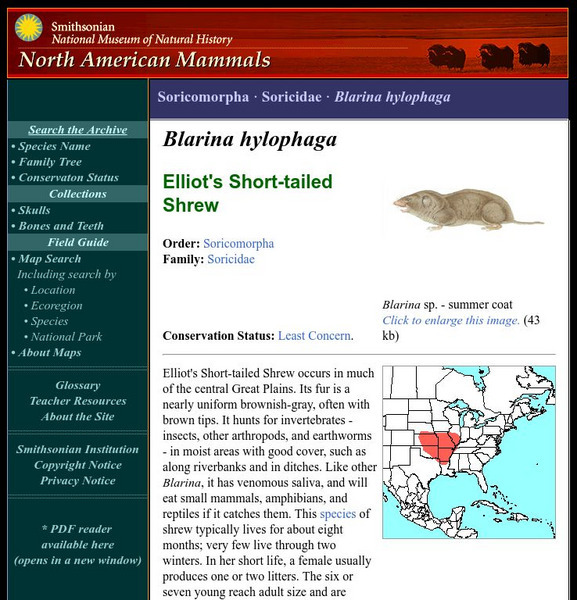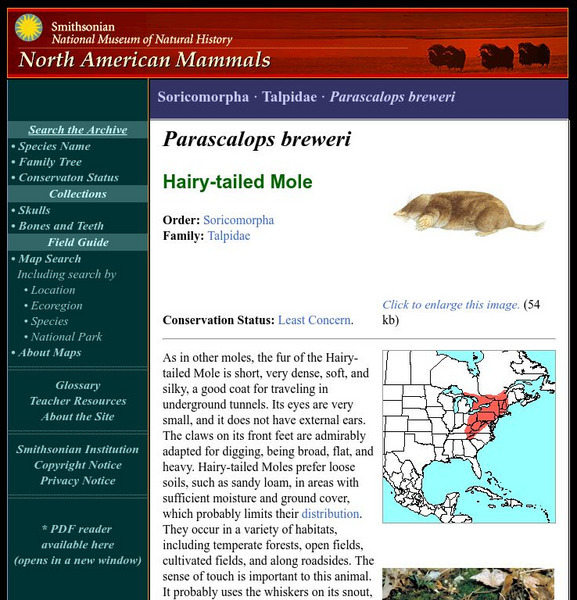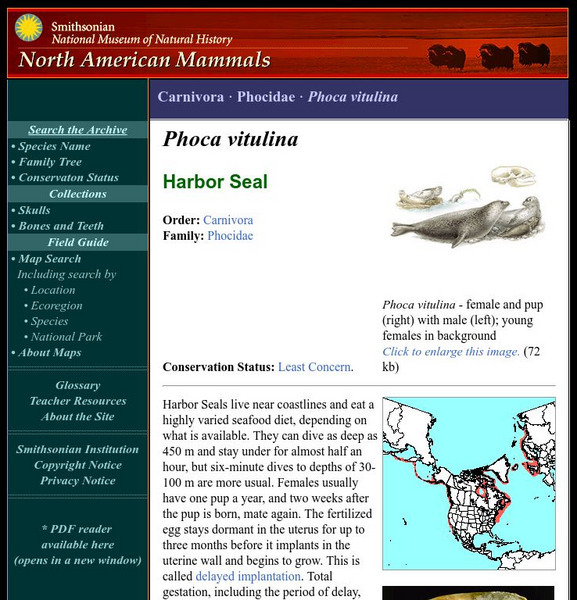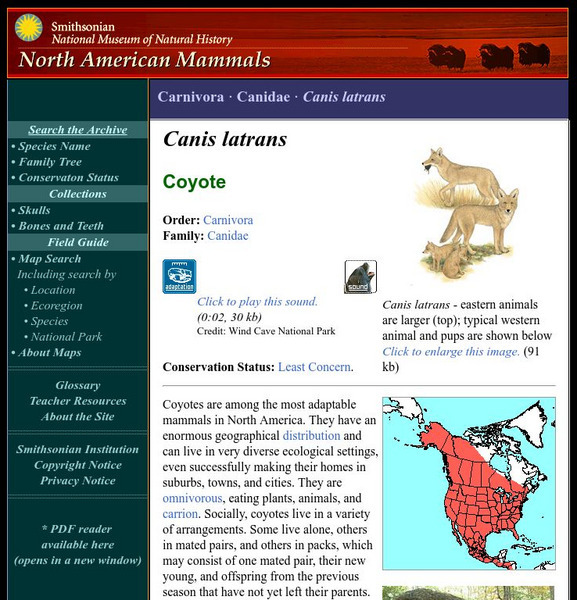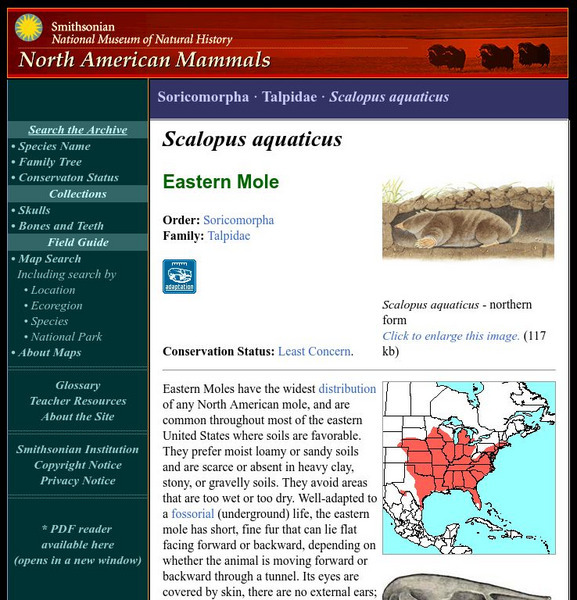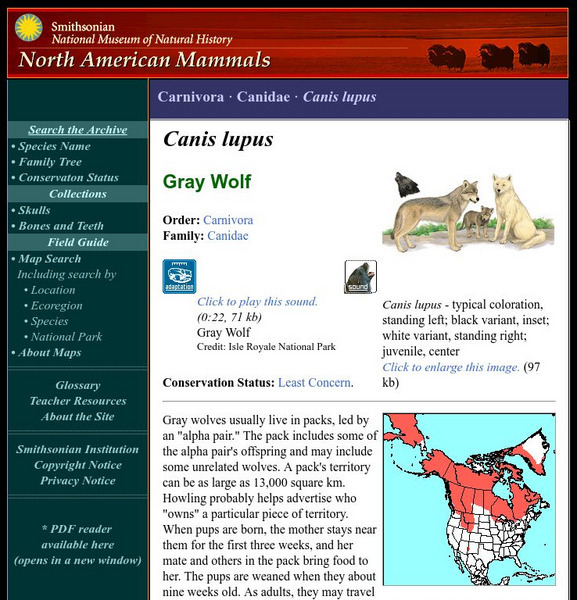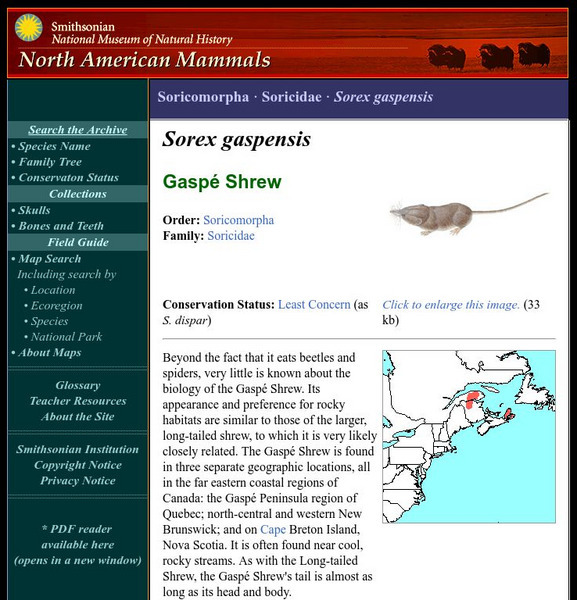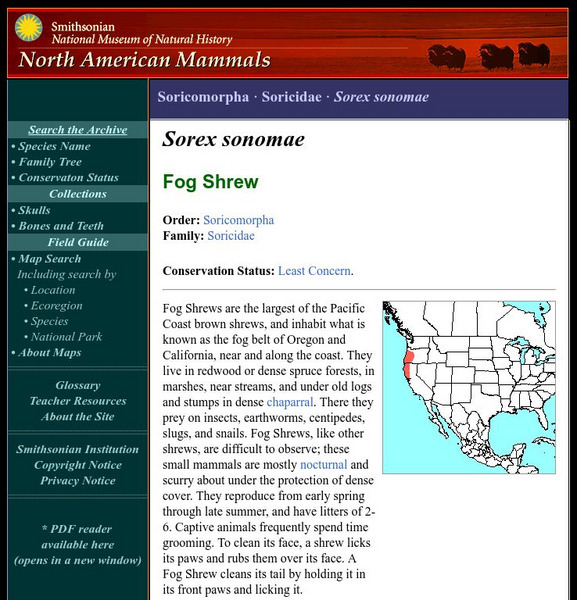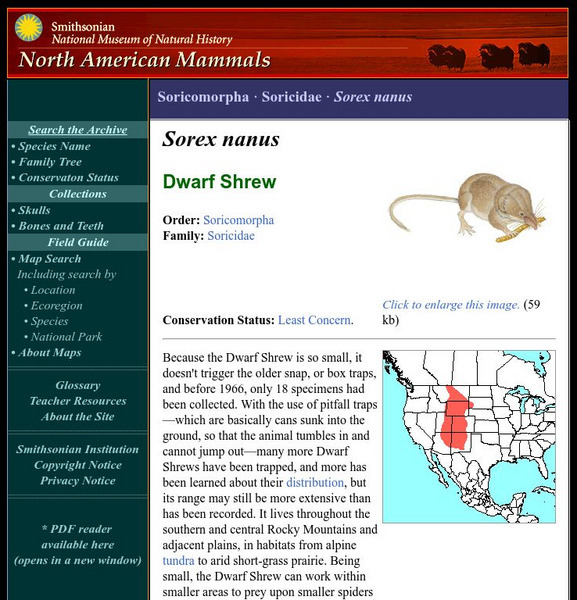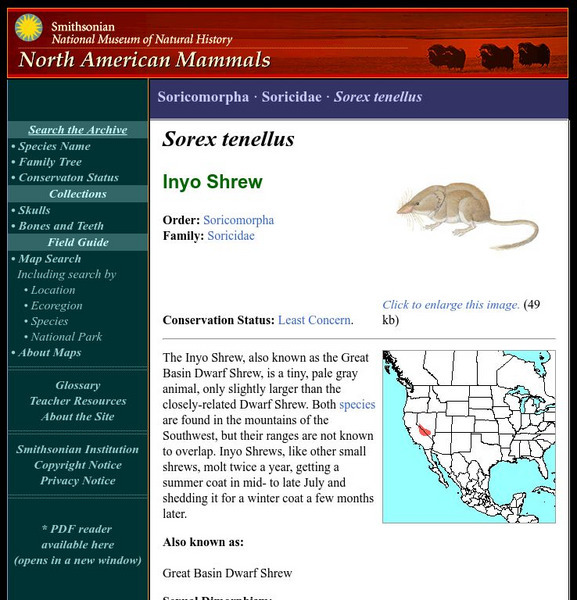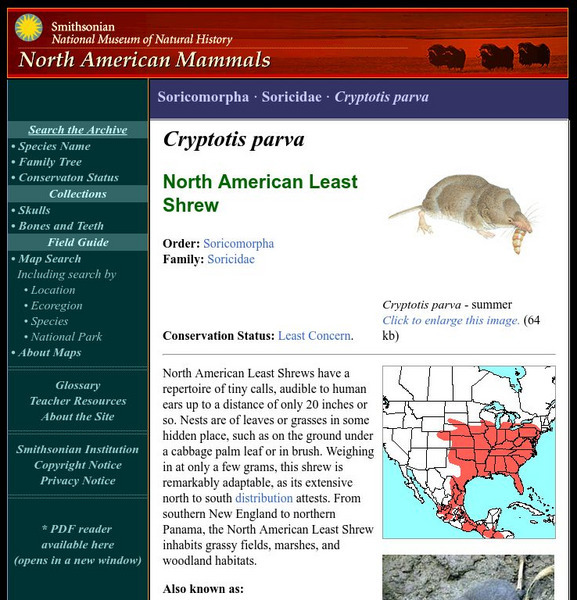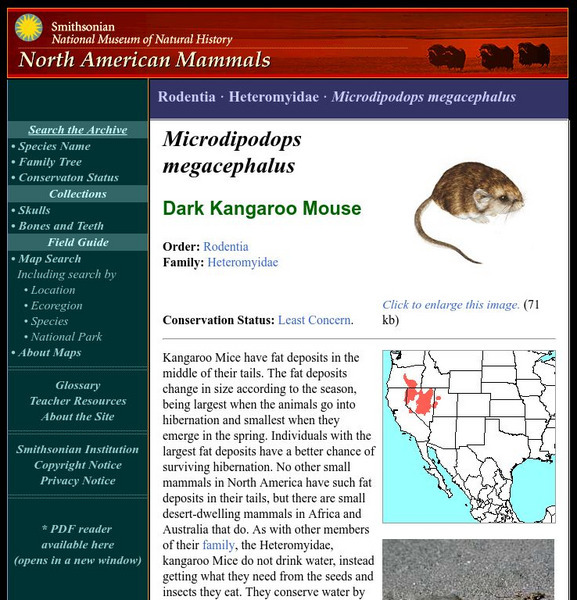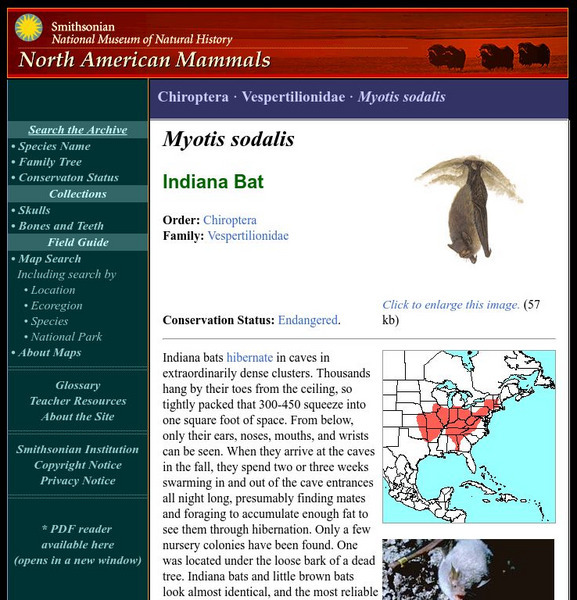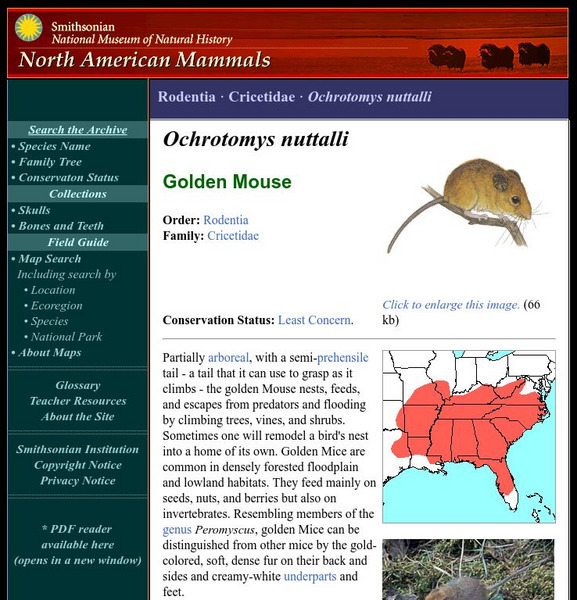Smithsonian Institution
National Museum of Natural History: American Mammals: Douglas' Squirrel
Douglas's Squirrels are small, energetic, and very active during the day all year long. They spend many hours collecting and storing green pine cones to eat during the harsh winters. Learn more about the Tamiasciurus douglasii, more...
Smithsonian Institution
National Museum of Natural History: American Mammals: Harris's Antelope Squirrel
Extreme heat does not deter Harris's Antelope Squirrel from vigorous daytime activity. It is agile, scampering over sharp-spined cholla cactus without being pricked, and may sit on top of a cactus to look around. Learn more about the...
Smithsonian Institution
National Museum of Natural History: American Mammals: Dulzura Kangaroo Rat
The Dulzura Kangaroo Rat is an excellent swimmer; its long hind feet are as well adapted for swimming as for hopping. On land, it usually makes short hops on its hind feet, but can hurry along using all four feet. Learn more about the...
Smithsonian Institution
National Museum of Natural History: American Mammals: Fresno Kangaroo Rat
As might be expected from its name, the Fresno Kangaroo Rat inhabits south-central California. The species is at risk because agriculture takes ever-increasing bits of its habitat. Learn more about the Dipodomys nitratoides, more...
Smithsonian Institution
National Museum of Natural History: American Mammals: Hispid Cotton Rat
The Hispid Cotton Rat's fur is sprinkled or streaked with blackish or dark brownish and grayish hairs. The Rats molt, losing and getting a new coat, three times in three months as they move through juvenile and subadult stages and into...
Smithsonian Institution
National Museum of Natural History: American Mammals: Gray Seal
Some 15,000 gray seal pups are born annually on a 25-mile-long sand bar on an island off the coast of Nova Scotia. This is far from the seals' feeding grounds, and both males and females fast during the mating and birthing season. Learn...
Smithsonian Institution
National Museum of Natural History: American Mammals: Jaguarundi
Jaguarundi are uniformly colored, rather than spotted, and are either reddish brown or dark gray. Both colors can appear in the same litter of kittens. Learn more about the Puma yaguarondi (Herpailurus yaguarondi), more commonly known as...
Smithsonian Institution
National Museum of Natural History: American Mammals: Crawford's Gray Shrew
These shrews live in deserts, but they seek out moister microhabitats within them, such as brush piles or fallen logs. They have been found in beehives, and their tiny, golfball-sized nests have been found in dens built by and sometimes...
Smithsonian Institution
National Museum of Natural History: American Mammals: Elliot's Short Tailed Shrew
Elliot's Short-tailed Shrew occurs in much of the central Great Plains. Its fur is a nearly uniform brownish-gray, often with brown tips. Learn more about the Blarina hylophaga, more commonly known as Elliot's Short-tailed Shrew, in this...
Smithsonian Institution
National Museum of Natural History: American Mammals: Hairy Tailed Mole
As in other moles, the fur of the Hairy-tailed Mole is short, very dense, soft, and silky, a good coat for traveling in underground tunnels. Its eyes are very small, and it does not have external ears. Learn more about the Parascalops...
Smithsonian Institution
National Museum of Natural History: American Mammals: Harbor Seal
Harbor Seals live near coastlines and eat a highly varied seafood diet, depending on what is available. They can dive as deep as 450 m and stay under for almost half an hour, but six-minute dives to depths of 30-100 m are more usual....
Smithsonian Institution
National Museum of Natural History: American Mammals: Coyote
Coyotes are among the most adaptable mammals in North America. They have an enormous geographical distribution and can live in very diverse ecological settings, even successfully making their homes in suburbs, towns, and cities. Learn...
Smithsonian Institution
National Museum of Natural History: American Mammals: Eastern Mole
Eastern Moles have the widest distribution of any North American mole and are common throughout most of the eastern United States where soils are favorable. They prefer moist loamy or sandy soils and are scarce or absent in heavy clay,...
Smithsonian Institution
National Museum of Natural History: American Mammals: Gray Wolf
Gray wolves usually live in packs, led by an "alpha pair." The pack includes some of the alpha pair's offspring and may include some unrelated wolves. Learn more about the Canis lupus, more commonly known as a Gray Wolf, in this...
Smithsonian Institution
National Museum of Natural History: American Mammals: Gaspae' Shrew
Beyond the fact that it eats beetles and spiders, very little is known about the biology of the Gaspe Shrew. Its appearance and preference for rocky habitats are similar to those of the larger, long-tailed shrew, to which it is very...
Smithsonian Institution
National Museum of Natural History: American Mammals: Fog Shrew
Fog Shrews are the largest of the Pacific Coast brown shrews, and inhabit what is known as the fog belt of Oregon and California, near and along the coast. They live in redwood or dense spruce forests, in marshes, near streams, and under...
Smithsonian Institution
National Museum of Natural History: American Mammals: Dwarf Shrew
Because the Dwarf Shrew is so small, it doesn't trigger the older snap or box traps, and before 1966, only 18 specimens had been collected. With the use of pitfall traps, which are basically cans sunk into the ground so that the animal...
Smithsonian Institution
National Museum of Natural History: American Mammals: Inyo Shrew
The Inyo Shrew, also known as the Great Basin Dwarf Shrew, is a tiny, pale gray animal, only slightly larger than the closely-related Dwarf Shrew. Both species are found in the mountains of the Southwest, but their ranges are not known...
Smithsonian Institution
National Museum of Natural History: American Mammals: North American Least Shrew
North American Least Shrews have a repertoire of tiny calls, audible to human ears up to a distance of only 20 inches or so. Nests are of leaves or grasses in some hidden place, such as on the ground under a cabbage palm leaf or in...
Smithsonian Institution
National Museum of Natural History: American Mammals: Dark Kangaroo Mouse
Kangaroo Mice have fat deposits in the middle of their tails. The fat deposits change in size according to the season, being largest when the animals go into hibernation and smallest when they emerge in the spring. Learn more about the...
Smithsonian Institution
National Museum of Natural History: American Mammals: Indiana Bat
Indiana bats hibernate in caves in extraordinarily dense clusters. Thousands hang by their toes from the ceiling, so tightly packed that 300-450 squeeze into one square foot of space. Learn more about the Myotis sodalis, more commonly...
Smithsonian Institution
National Museum of Natural History: American Mammals: Keen's Myotis
Keen's myotis is a medium-sized bat with a long tail. It does not demonstrate narrowly specialized habitat needs. Learn more about the Myotis keenii, more commonly known as a Keen's Myotis, in this easy-to-read species overview by the...
Smithsonian Institution
National Museum of Natural History: American Mammals: Golden Mouse
Partially arboreal, with a semi-prehensile tail - a tail that it can use to grasp as it climbs - the golden Mouse nests, feeds, and escapes from predators and flooding by climbing trees, vines, and shrubs. Sometimes one will remodel a...
Smithsonian Institution
National Museum of Natural History: American Mammals: Great Basin Pocket Mouse
The Great Basin Pocket Mouse is the largest member of the genus. It inhabits arid and semi-arid habitats in nearly the entire Great Basin region of western North America, particularly where sagebrush dominates the vegetation. Learn more...
